This is a Welta Superfekta, a folding Twin Lens Reflex camera built by Welta Kamerawerke in Freital, Germany starting in 1935. The Superfekta was an upgraded model of the earlier Perfekta, offering larger 6cm x 9cm exposures using a rotating film back capable of both landscape and portrait oriented photos using the same waist level reflex finder. The Superfekta was a large, heavy, and very advanced camera, offering Zeiss lenses, Compur-Rapid shutters, an exposure counter, and a moving film mask in the viewfinder that always showed the correct orientation. The Superfekta is a one of a kind camera, offering a folding TLR 6×9 design with a long list of advanced features.
Film Type: 120 Roll Film (eight 6cm x 9cm exposures per roll)
Lens (Taking): 10.5cm f/3.8 Carl Zeiss Jena Tessar uncoated 4-elements in 3-groups
Lens (Viewing): 7.5cm f/3.8 Weltaskop uncoated unknown elements
Focus: 1.5 meters to Infinity
Viewfinder: Coupled Waist Level Reflex Viewfinder w/ Movable Portrait and Landscape Masks
Shutter: Compur Leaf
Speeds: T, B, 1 – 1/250 seconds
Exposure Meter: None
Battery: None
Flash Mount: None
Other Features: Self-Timer
Weight: 1340 grams
Manual: None
How these ratings work |
The Welta Superfekta is perhaps the strangest Twin Lens Reflex camera ever made. Shooting 6cm x 9cm images on 120 film in both portrait and landscape orientation requires a huge number of differences from that of a solid bodied 6×6 TLR. This camera has a steep learning curve as it’s various functions aren’t always obvious to the user, but once you get the hang of it, this is a really fun camera to shoot that makes excellent photos. It is certainly not something I would ever shoot regular, but whenever I do, it puts a smile on my face! | ||||||
| Images | Handling | Features | Viewfinder | Feel & Beauty | History | Age | |
| 2 | 0 | 2 | 1 | 2 | 2 | 40% | |
| Bonus | none | ||||||
| Final Score | 12.6 | ||||||
History
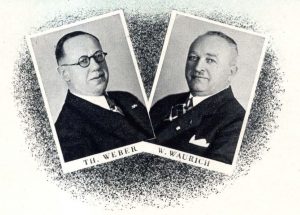
Welta is yet another camera company from the Dresden area of Germany where a huge number of camera makers were based in the early to mid 20th century. Founded in 1914 by German businessmen, Theodor Weber and Walter Waurich in Freital, a nearby suburb of Dresden. Originally named Weeka-Kamera-Werk, the company changed it’s name to Welta-Kamera-Werk in 1919 to include the name Welta which was taken from their early plate cameras.
As was the case of many Dresden area camera makers, Welta had to complete with a large number of companies making similar products. Welta would attempt to carve out a market for themselves by selling a lot of “white label” products to dealers, and by exporting their cameras to other markets including the United States.
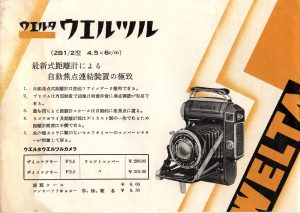
Welta was one of the first German makers to actively market their cameras in Japan, selling models like the roll film Weltur in the mid 1930s. The page to the right shows the camera in a Japanese language catalog dated April 1936 along with several other of the company’s models. The Japanese camera market was still in it’s infancy in those days, so being able to get German made products would have likely made them very appealing to photographers at the time.
Along with their export business, Welta produced a number of higher spec cameras for the German market. One such camera was the Welta Perfekta, a medium format folding twin lens reflex camera. Twin lens reflexes were gaining popularity in the early 1930s based off success from Franke & Heidecke’s Rolleiflex TLR first released in 1929.
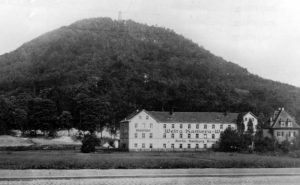
The idea for a solid bodied camera with a through the lens viewfinder was first credited to Reinhold Heidecke, who while working for Voigtländer, came across a folding Vest Pocket camera sitting in his basement that had become rotted out due to moisture. Heidecke, knowing the Vest Pocket camera’s popularity with solders on the battlefield, wanted to design something that was more rugged and could better resist moisture damage. His presented his vision to his employers at Voigtländer who had no interest in building the camera.
Unfazed by this rejection, Heidecke would eventually meet up with Paul Franke and would later form Franke & Heidecke in 1920. The early days of Heidecke’s new company saw them with little funding so the company concentrated on simple stereo cameras that were popular at the time, but once the company had more capital, Heidecke was now free to built his new camera, which would eventually become the Rolleiflex.
Although the TLR’s original concept was as a battlefield camera, it was rarely used that way, instead being the camera of choice for professional photographers who wanted the benefit of through the lens composition and focus, but without the complexity of a Single Lens Reflex. Although SLR cameras did exist prior to the TLR, they were often big, slow, and had very dim viewfinders. Heidecke’s TLR solved all of those problems and quickly caught on as the professional’s camera of choice.
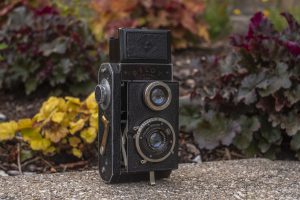
Perhaps looking to jump onto the TLR bandwagon, but take a cue from the earlier Kamera Werkstätten Pilot, around 1932 Welta would release a folding TLR called the Perfekta. This new camera would mimic the concept of the Rolleiflex, but instead of being in a solid metal body, had a folding bellows body. In order to make the camera fold, while still having the benefit of a life size reflex viewfinder, only the main part of the Perfekta folded, while the viewfinder, reflex mirror, and ground glass, would remain at the top of the camera in a sort of T-shape.
The design was strange indeed, and although technically smaller than a Rolleiflex, didn’t exactly fit into a vest pocket. The camera was more suitable to fit into a large coat pocket with the viewfinder part sticking out, or carried around in it’s proprietary leather ever ready case.
I can’t say for sure how successful the Perfekta was, but at the very least, it wasn’t an abysmal failure, as there was clearly enough demand for an even larger, and more advanced model, which in 1935 would be released as the Superfekta. Contrary to often repeated information found online that suggests the Superfekta was released in 1932, it didn’t appear until 1935, after the smaller, Perfekta.
The Superfekta retained the same folding concept as the earlier Perfekta, but made larger 6cm x 9cm images, and had a rotating back, meaning the camera could be used in both a portrait and landscape orientation, using the same reflex viewfinder.
Like the earlier model, the Superfekta could be bought with both Meyer Trioplan and Carl Zeiss Tessar lenses. The Perfekta could be had with both Compur and Compur-Rapid shutters, but the Superfekta only offered the Compur-Rapid. Using the German language catalog above, with the same Zeiss Tessar lens and Compur-Rapid shutter, the Superfekta sold for 60 RM more, representing nearly a 45% premium. A baffle for shooting 4.5cm x 6cm images was also available on the Superfekta.
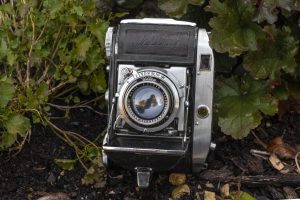
Despite having a large export market to both American and Japanese photo dealers, the company’s two folding TLRs seem to be German market only cameras as I’ve found no evidence of them in any contemporary catalogs I have seen. By far, the company’s simpler compact folding and 35mm cameras like the Waltax and Weltini were much more commonly exported.
In a 2005 article from the UK magazine Amateur Photographer, author and collector Ivan Matanle mentions a 1935 price of £13 10s for the Perfekta with f/3.5 Trioplan lens, suggesting the camera was exported to the UK.
Although I am pretty certain the Superfekta began production in 1935, when it stopped is not clear. The Welta catalog above is said to be from 1939, and there’s other sites online suggesting the camera was produced until 1940, but I cannot confirm that. If I had to guess which of the two is correct, based on my knowledge of the German camera industry at the time, plus other Welta models, I would suggest that late 1938 to early 1939 seems the most likely.
By the start of World War II, a combination of an abundance of competition from other German camera makers, and a shift in demand for wartime production, many of Welta’s earlier cameras would be discontinued. 35mm models like the Weltini would continue to be produced, and even revived after the war, but models like the Perfekta and Superfekta would never again be made.
From 1948 and on, Welta would be a state-owned company known as VEB Welta-Kamera-Werk. Some models like the Welti would continue to be produced, but the rangefinder equipped Weltini was not one of them. The Welti would stay in production with some cosmetic changes and different lenses for quite some time. Instead of Schneider Xenons and the rare Leitz Elmar, the most common lenses were Zeiss Tessar and Meyer Trioplan lenses in Vebur and Cludor shutters.
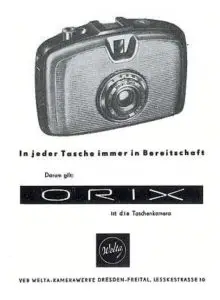
Welta would continue to manufacture cameras using their own designs from before the war. In 1950, Welta would merge with Kamera-Werk Tharandt who themselves were once two separate companies known as Richter and Merkel. VEB Welta-Kamera-Werk would continue on, making lower cost East German versions of prewar Dresden area cameras until 1959 when the company merged to become VEB Kamera-and Kinowerk Dresden and later VEB Pentacon Dresden. The Welta name would continue to be used until about 1961. One of the last cameras produced with the Welta name was a compact half frame camera using AGFA Rapid film called the Welta Orix. Under Pentacon’s ownership, the Orix would be renamed the Pentacon Penti I and II and remained in production as a Pentacon design until 1977, officially putting to end, Welta’s lineage.
As with most East German companies, their subsequent mergers into KW and later Pentacon spelled the end for the company. In the later 20th century, the East German photo industry became a single entity, with little to nothing remaining of the companies who came before them.
Today, prewar German cameras are highly collectible. With a huge number of formats, sizes, and companies, you could base an entire collection just on these cameras. Of them all however, the Welta Superfekta might be the strangest looking and most unique. To call these cameras collectible is an understatement, but with high desirability comes a high price. These cameras were not sold in large numbers, so few are available today, making prices on them very high. If you have a chance to pick one of these up at a price you can live with, definitely do it as you may never have another chance again. Even if you just a chance to handle one from someone else collection, don’t pass up the chance as it’s a camera you’re likely never going to forget.
My Thoughts

The first time I ever saw a Superfekta in person was in 2019 at a camera show in West Chester, Ohio near Cincinnati. This was the first time I had met my friend and Camerosity Podcast co-host, Paul Rybolt in person. I had gone down there to hang out both with Paul and Dan Arnold, and of course see what kinds of strange and unusual cameras would be there.
On a table from some collector who clearly prices his cameras too high was a Superfekta. I don’t remember the name of the seller, or how much he was asking for it, but based on the thick layer of dust and the price tag he had attached to it, he had this camera for quite some time, unwilling to come down on his asking price. I wouldn’t be surprised if he still has that same camera for sale at the same price.
I remember being amazed not only at the design of a folding TLR, but one with a rotating back that could shoot both portrait or landscape 6×9 images. What a strange design I thought, but quickly put it out of my mind as I would never come close to paying the asking price for it.
Fast forward to early 2022, and I get an email from site reader, James Thorpe, who asked me if I’d be interested in reviewing not only a Superfekta, but the “regular” Perfekta. Of course, I said! A couple days went by and eventually this huge box shows up at my door. Wow, what a big box I thought just for two cameras.
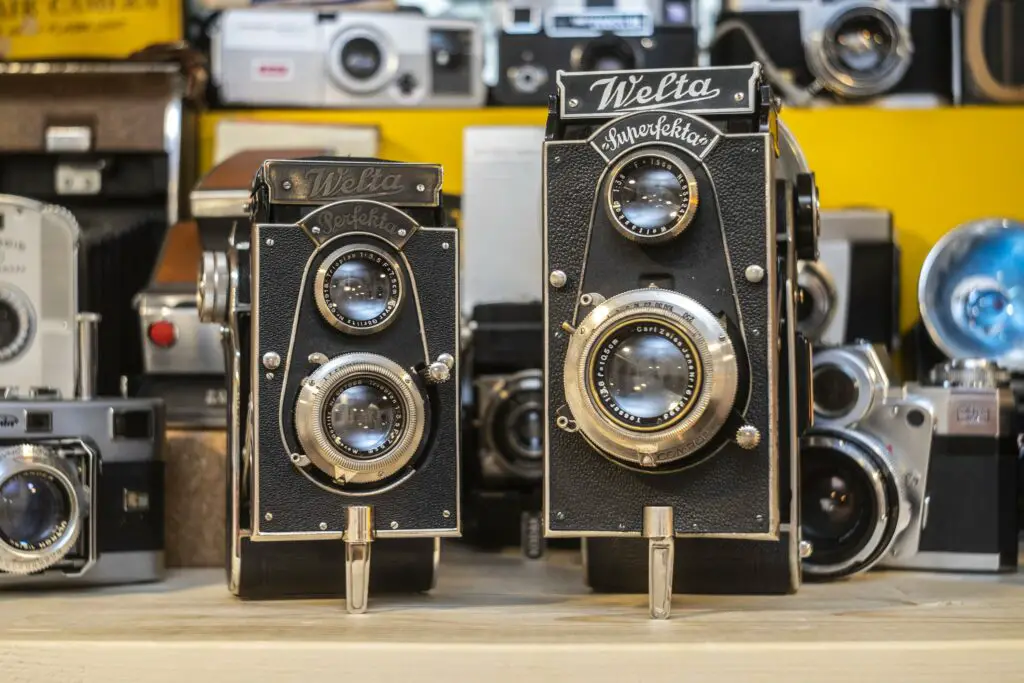
As it turned out James didn’t send me a Superfekta and a Perfketa, he sent me two of each! Apparently he had two variants of each and wanted me to look at both. Intimidated by the operation of both cameras, they sat in my camera room for a while before I had a chance to take one out. For the first of the four cameras, I chose this Superfekta as it was the nicer of the two and had a clear Zeiss Tessar lens.
If there ever was a camera that deserved to be called “Super” this is it. The Superfekta is supersized in every dimension. You’d think that the point of a folding TLR was to make it compact, but this camera is very large and very heavy. With an empty film compartment, the Superfekta tips the scales at a whopping 1340 grams, or just under 3 pounds. Sitting in a table with the hood up, the camera is about 25.5 cm or about 10.5 inches tall. This is easily about 6.5 cm or 2.5 inches taller than a Rolleiflex with it’s hood open. Even with the viewfinder down, the Superfekta is barely smaller than the Rollei with it’s hood still up. This is a big camera.
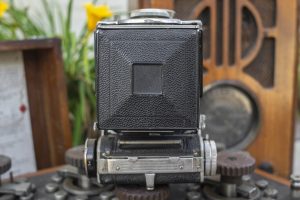
Starting with the top, the Superfekta has what looks to be a pretty normal square waist level finder, like you’d expect to see on any normal TLR. Wait a minute, didn’t I say this was a 6×9 camera? Why does it have a square viewfinder?
Turns out the designers at Welta took into account that people would want to see an accurate rectangle representation of their image both in landscape or portrait orientations. To accommodate this, the square viewfinder has two pairs of metal masks that are hinged on opposite ends. When rotating the film back from portrait to landscape orientation, some kind of internal linkage causes these masks to pivot. In portrait orientation, they’re on the sides, but in landscape, they rotate to be on the top and bottom. It’s a pretty clever system that actually works quite well. So while the ground glass is square, you can only ever see a rectangle image that is consistent with the orientation of the back.
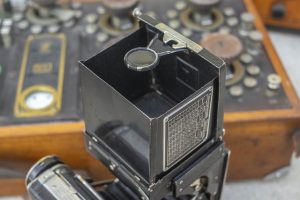
Like with most TLRs, a hinged magnifying glass is on the inside of the lid that can be folded up for precision focus. There is no sports finder in the viewfinder hood, but a folding frame viewfinder on the side of the body can be used for the same purpose.
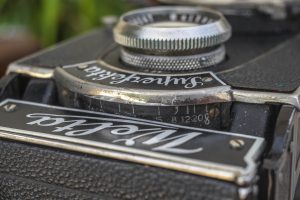
In front of the folding viewfinder and above the “Superfekta” logo plate is the focusing scale. The scale is somewhat obscured by the Welta name plate, making reading the middle numbers difficult. The scale is in meters only and is indicated by a small metal finger that slides left to right depending on what distance the camera is focused to.
Looking down from the top on the main body of the camera, we also see the latch for the film compartment with a sliding lever behind it to open, but also on the left, is the opening for the exposure counter. The Superfekta has a built in exposure counter which counts off 1 through 8 without having to use the red window in the door.
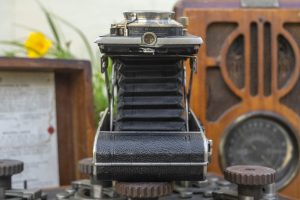
Flip the camera over, and on the base of the lens and shutter board is a folding kickstand which supports the camera sitting on a flat surface with the back in portrait orientation. Unfortunately, there is no way to set the camera down on a flat surface with it in landscape mode on account of the film advance knob on one side of the film back. On the leading edge of the shutter board is a 3/8″ tripod socket which can support the camera in both portrait and landscape orientations.
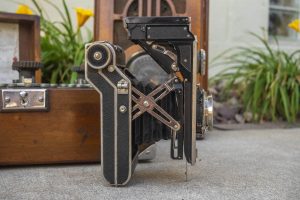
With the camera in portrait orientation, the camera’s right side has the previously mentioned film advance knob which can be pulled away from the body while installing film to clear the film spool post. Below the advance knob is a small button for opening the front of the camera. Two sets of very tightly sprung scissor struts will push open the front of the camera with a good amount of force, so be careful. Below the release button is some type of post that appears to be notched perhaps for some kind of strap, but I cannot be sure. I’ve found no manual for this camera online, and this piece does not exist on the regular Perfekta so I have no idea what it is. Below that is a small snap for connecting the leather ever ready case. An identical snap is on the opposite side of the camera as well. Finally, with the viewfinder hood open, this side of the camera also shows a German language depth of field chart.
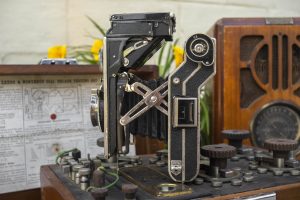
On the left, near the top of the body is the exposure counter. A duplicate reading can be taken from the counter on the side as on the top. Numbers showing 1 through 8 can be read without using the red window on the back of the camera. A sliding knob in the center of the exposure counter has the letters A and E. The “E” position is for normal operation, using a geared wheel connected to the take up spool to count upwards, and the “A” position resets it back to 1 after loading in a new roll of film. The counter will also automatically reset in “E” mode after reaching the end of a roll of film. Below the counter is a folding metal frame to be used as a sports or quick action finder when the waist level finder is not needed, and below that, near the bottom of this side of the camera is another one of those strange looking posts like seen on the other side of the camera,.
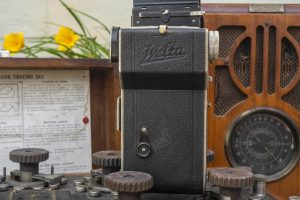
Around back, the rear door has a large embossed Welta logo near the top, immediately below the back edge of the film door release slider. Near the bottom left corner of the door is the red window fore viewing the exposure numbers on the film backing paper. A rotating metal door can be used to protect the window from extra light when in use.
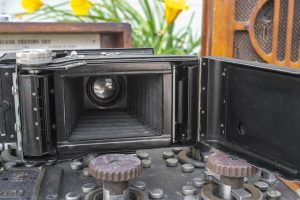
With the bottom hinged (with the camera in portrait orientation) film door open, film transports from the bottom to the top. In landscape, it transports left to right. Both the supply and take up spools sit in metal compartments that are hinged and pivot out of the camera, making installing both spools very easy. Before you can swing out the take up spool, you’ll need to pull the film advance knob away from the body so that the compartment can clear the shaft. When installing a new roll of film, make sure the paper leader stretches across the film gate and is securely attached to the take up spool. Once everything is attached, fold the spools back into the camera. The film compartment has a crooked shape because the take up side juts further out of the back of the camera than the supply side is. This looks awkward when loading film as the paper is not parallel to the film plane, but a roller on the inside of the film door will push down on the paper leader, keeping it inline with the film plane when the door is shut.
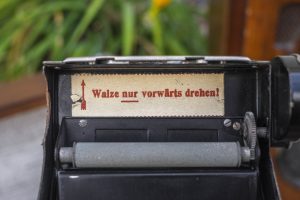
On the inside of the door is a large and smooth black painted pressure plate with only a single round hole for the red window. You can see the toothed shaft on the exposure counter side which detects the motion of the film when it transports through the camera, making the exposure counter work. After loading film into the camera and closing the door, you must use the red window to find the first exposure. Once you can see the number ‘1’ in the window, close the door for the window and reset the body’s exposure counter back to one by sliding the switch to the “A” position and then back to “E” for normal operation. For exposures 2 through 8, you can use the exposure counter without having to look at the red window.
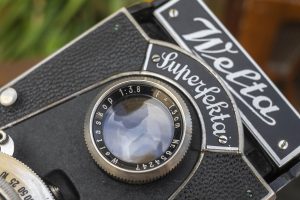
Up front, we see both the viewfinder and taking lenses. Although the taking lens on this camera is a Carl Zeiss Jena Tessar 10.5cm f/3.8 lens, the viewfinder lens is a Weltaskop 7.5cm f/3.8 lens. The difference in focal length is to account for the design of the viewfinder which shows a proper 6×9 image on a 6×6 ground glass using masks. Had they used an identical 10.5cm viewfinder lens, the masks would cover up some of the visible image captured on film.
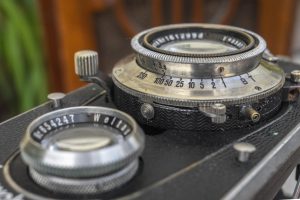
The Compur shutter is not coupled to the film transport, which means you must manually cock the shutter after advancing the film but before making your exposure. This makes double exposures very easy to do, if you want, but also increases the chances it happens unintentionally. A small sliding button near the other side of the film cocking lever is the self-timer. To activate it, slide the button towards the camera body while cocking the shutter. Doing so will allow the cocking lever to go beyond it’s normal end point to a point where it activates the self timer. When firing the shutter, there will be an approximate 10 second delay before the cocking lever returns to it’s normal position, at which point the shutter will fire.
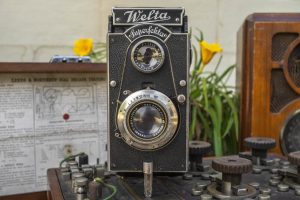
The shutter release is near the 8 o’clock position around the shutter, immediately below a cable release socket. Shutter speeds are chosen using the large nickel plated ring around the perimeter of the shutter. Speeds from 1 to 1/250 can be chosen plus T and B. As with early non-Synchro Compur shutters, both T and B can be used without cocking the shutter. In fact, if you cock the shutter and then try to turn the speed selector to T or B, it won’t let you. The shutter must be uncocked before you can use either of these settings. Aperture f/stops are changed by rotating the round around the perimeter of the taking lens.
A large handle near the 3 o’clock position is used for focus. Movement of this lever is smooth but firm, as it needs to move both the shutter, taking, and viewfinder lenses. Because the two lenses have different focal lengths, the distance both lenses move from minimum to infinity focus is not the same. While this wasn’t a problem on this particular Superfekta, I have to imagine the internal couplings needed to make this happen are a camera repair person’s nightmare! Finally two nickel plated buttons on each side of the shutter plate, between the two lenses, are used to fold the camera back shut. Under normal operation the scissor struts are locked into position, so pressing on both these buttons while pushing in on the entire shutter plate is needed to close the camera.
After having typed all this up, I feel like the Superfekta is one of the more unusual and difficult to describe cameras that I’ve ever reviewed, so I made this little video walking you through all of the various operations described above. I wish I had a better setup for creating videos, as I think this could be a nice complement to reviews, but I think in this case, it is a necessity!
The Superfekta is a strange camera indeed. Filled with strange controls in unusual locations with features not common on any other camera ever made. This is one of the most unusual cameras I’ve ever seen, but once you get used to it, it’s operation is actually quite easy to use. Aside from it’s huge size and heavy weight, it really does shoot like a regular TLR. But what kinds of images does it make? Keep reading!
My Results
With such an unusual camera, I did something unusual and shot my first two rolls of film in the Superfekta back to back. First was a roll of Foma 100 and the second the new Kodak Gold 200 that was recently released. Both rolls were freshly bought from Adorama (or was it B&H?) so should be pretty representative not only of each film, but also what the 90 year old Welta is capable of.
I am always torn when shooting prewar cameras with uncoated lenses, whether I should bother with color film, or just stick with black and white like a majority of the original owners would have. That’s not to say that uncoated lenses aren’t capable of shooting color film, it’s just that you’ll often get softer images with less than accurate color rendition. Then again, I’m not likely to get too many opportunities to shoot a perfectly working Welta Superfekta.
In the end, I am glad I chose to do both color and black and white though, as the results from both were outstanding. The fresh Kodak Gold 200 did show a slight lack of contrast, but not in a way that negatively impacted the images. In fact, the somewhat softness of the images gave them a look that’s distinct enough from other, more technically perfect 6×9 cameras might have delivered that look too real.
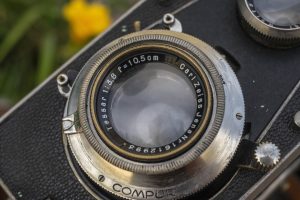
The black and white Foma images, as expected were excellent. Sharpness was great corner to corner, without any noticeable softness or vignetting near the corners. I am not one for pixel peeping film scans, but even if I had, I likely wouldn’t have found much to complain about. Simply, the Carl Zeiss Tessar did what all other Carl Zeiss Tessars do, which is make excellent images.
If there was one very minor issue I saw with the images, it had nothing to do with the lens, rather than the film gate on the Superekta produced tapered edges in the extreme corners of the images. These edges ended up being cropped off in most of my scans, but are visible on the exposed film. I am not sure exactly what causes this as the film gate in the camera looks fine.
There are a lot of adjectives I could use to describe shooting the Superfekta. Strange, heavy, awkward, unique, and fun are just some. If looking at images of this camera, you remark about how strange it looks, imagine trying to walk around with this thing hanging from your neck. Although the swiveling back works fine, it is disconcerting to feel half of a 3 pound camera rotating around itself. The bellows are more exposed than on typical folding cameras, as my left hand naturally wanted to stabilize the front of the camera beneath the shutter, which is precariously close to the bottom of the bellows. Even if you manage to get used to where to position your hand so as not to risk touching the sensitive leather, rotating the camera between horizontal and landscape moves everything around, requiring you to hold your hands differently.
The viewfinder worked as well as any medium format reflex camera, but also like cameras of this vintage, was very dark. As you can see in the images above, other than the mirror selfie, I shot this camera entirely outside in very good lighting. Attempting to shoot the Superfekta in heavy shade or indoors would have been a very miserable experience. If I was crazy enough to make this a regular use camera, I would very much consider replacing both the mirror and the focusing screen with a more modern and brighter one.
Despite what sounds like an awful lot of complaints, I genuinely enjoyed shooting the Superfekta. It’s shape, size, and ergonomics are unlike any camera I’ve ever shot, but therein lied some of the fun.
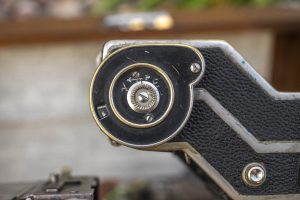
One of many cool things about the Superfekta is the exposure counter, which worked perfectly. I’ve seen this style of roll film exposure counter before on cameras like the Kodak Monitor Six-20 and Kodak Medalist, the Kochmann Reflex-Korelle, and a few others, and they almost never work. While shooting both rolls of film, I regularly looked at the numbers showing in the exposure counter and then looked at the backing paper number in the red window and in every case, the numbers matched perfectly.
The Superfekta is without a doubt one of the strangest looking and operating twin lens reflex cameras ever made. Almost every part of it’s operation is unorthodox and requires a bit of familiarization with the manual before using. It’s a fragile camera too, as it’s various moving parts expose the bellows much more than normal folding cameras, so you really need to take care of it while shooting.
Although this camera was a loaner to me, even if I did own it, I doubt I would take it out too often, but I am certain that every time I did, I would have a smile on my face. These cameras are not common, and when they do show up for sale, they usually fetch pretty high prices. Whether you are a collector or a user, you may or may not want to add one to your collection, but even if you don’t, if you get a chance to handle one even if just for a minute, I definitely recommend it!
Related Posts You Might Enjoy
External Links
http://camera-wiki.org/wiki/Superfekta
https://www.120folder.com/welta_perfekta.htm
https://www.collection-appareils.fr/x/html/appareil-1169.html

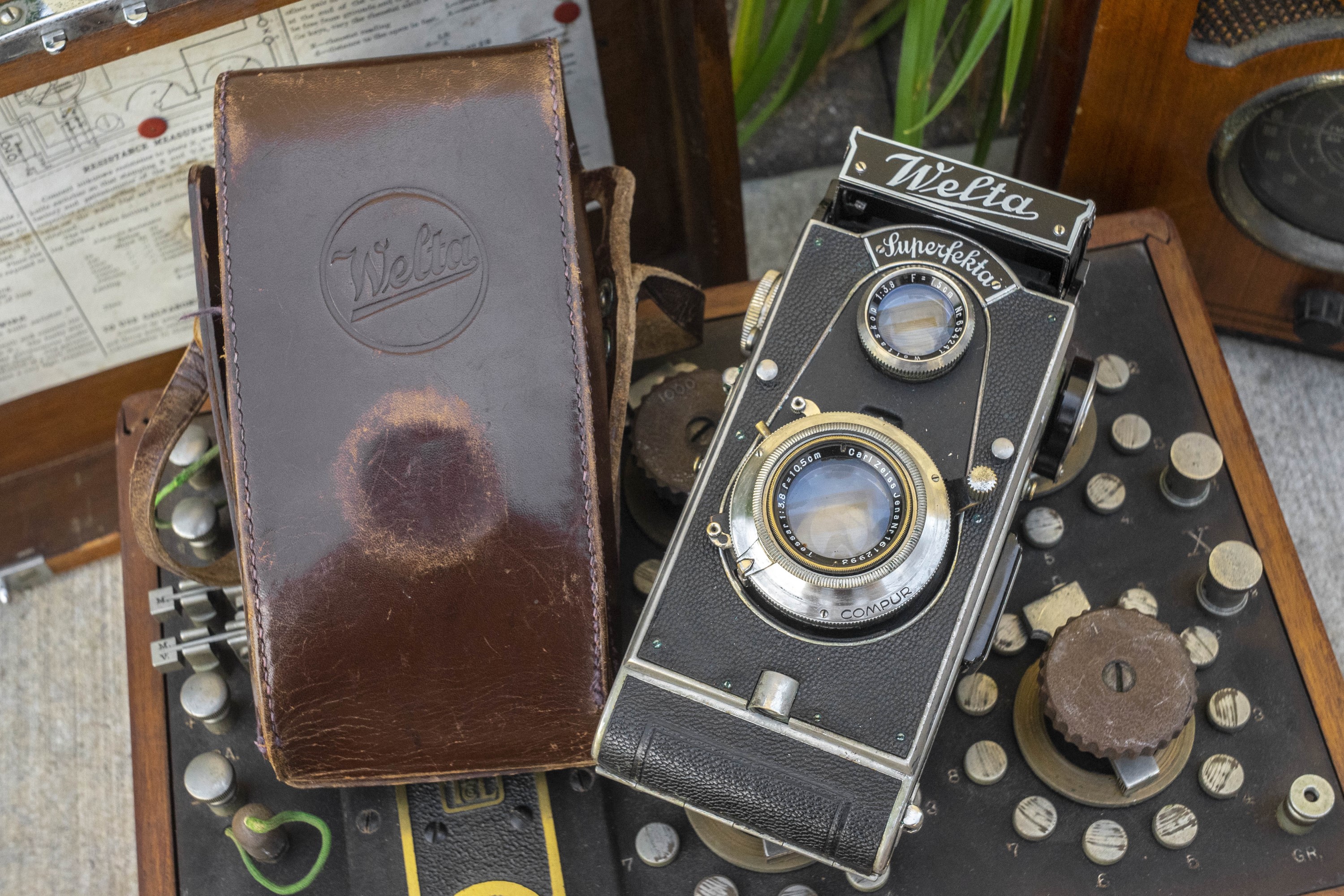
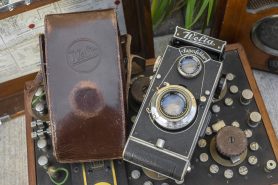
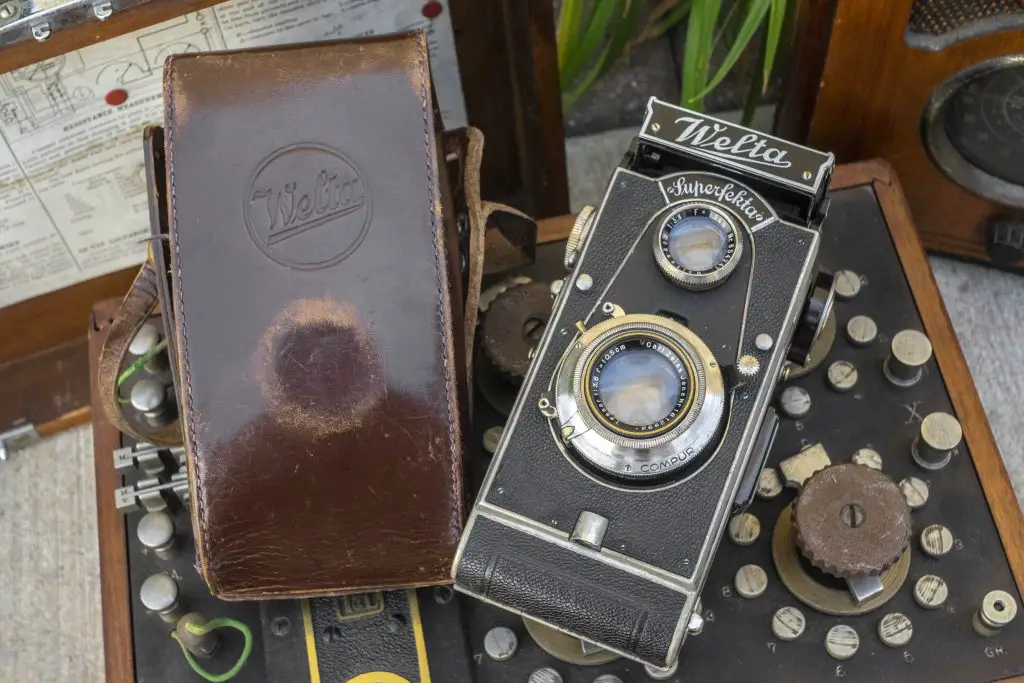
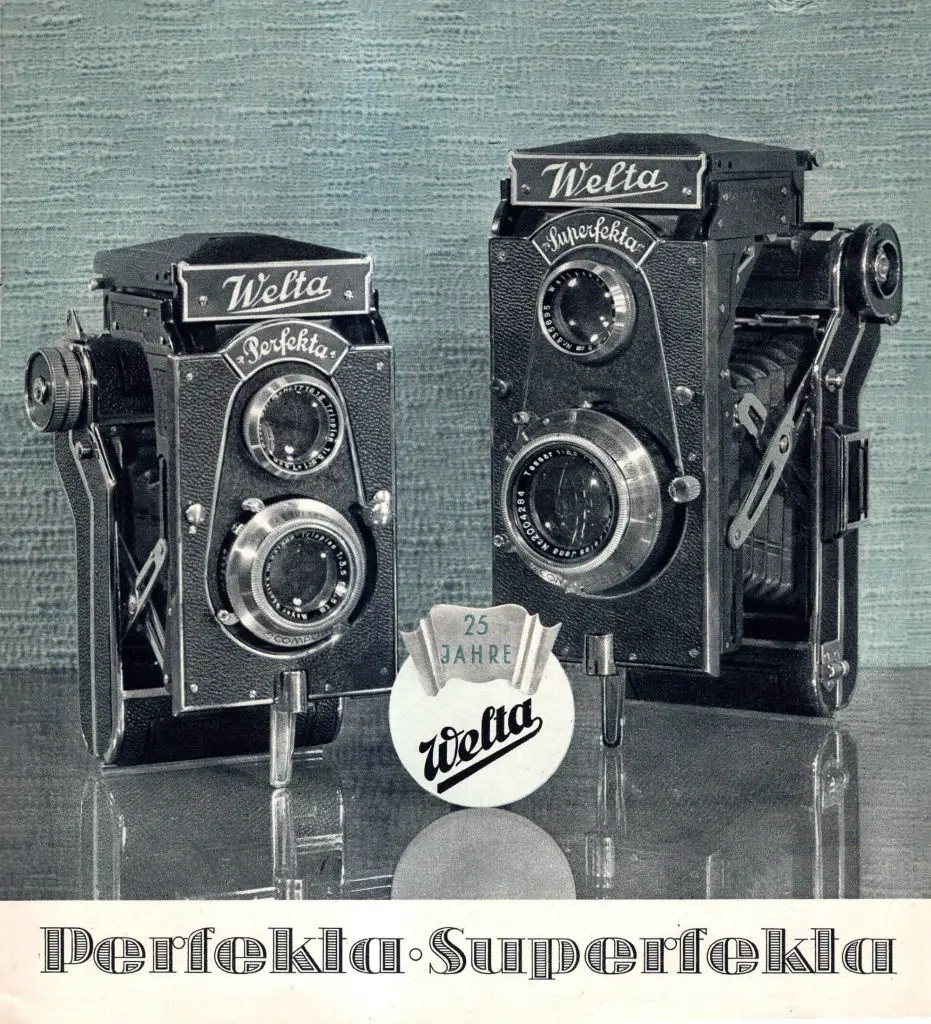
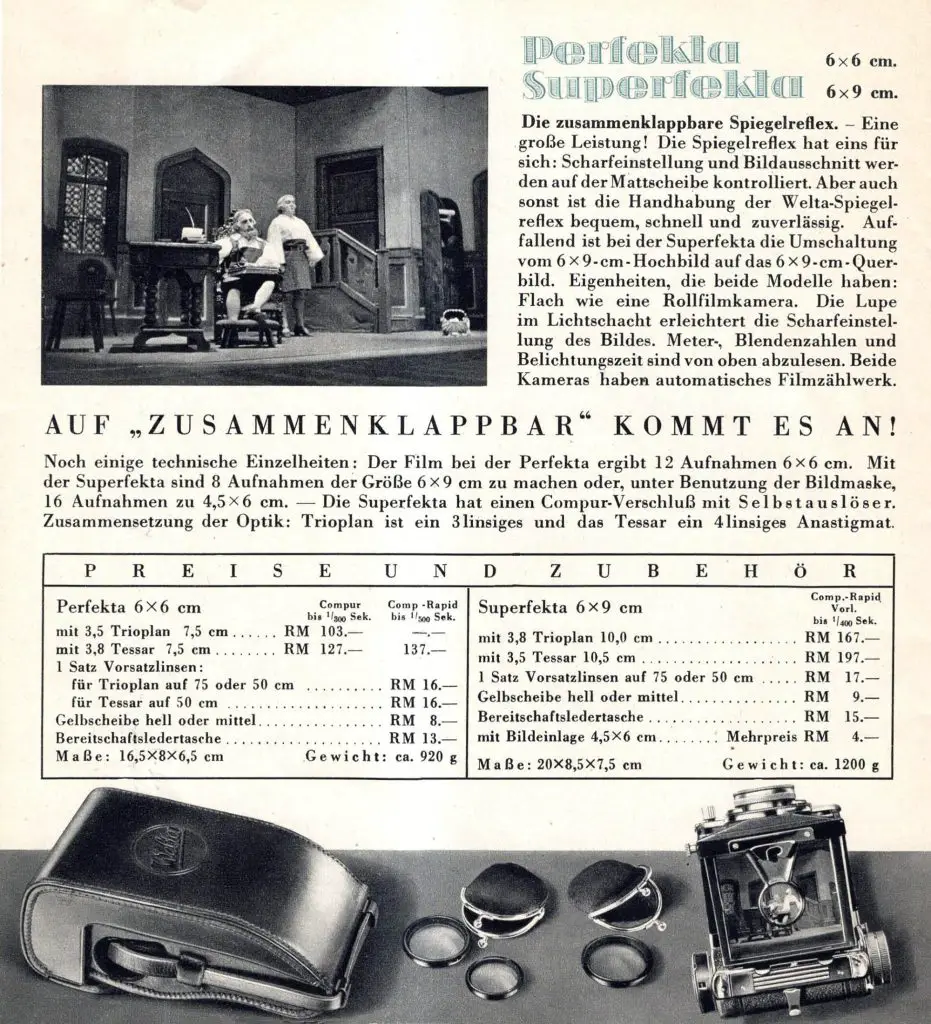
















Really great article, I am always amazed at the quality of the images older cameras produce. Thanks for this review.
Great article. Scanned 6×9 can still hold its own against digital.
Welta was quite a company. The Weltur was actually one of their high end cameras. Coupled rangefinder, fast Zeiss optics, auto lofting. Very well built and compact. Would love to find one of these TLRs some day.
Thanks for including the video on this one, I had a hard time visualizing exactly how it switched from landscape to portrait. Or rather, I didn’t believe the image that was in my head. Another fun review of a camera I had no idea about.
Glad you enjoyed the video. That’s why I included it as I thought this camera was so strange that a video would be more effective at showing how it worked!
Very informative video – this camera is a bit out of my price range, so it’s a treat to see a detailed review. Now Mike, tell us: Those overloaded shelves in the video background: Is that your collection?
Yep, those are my shelves! I just built them a couple months ago when we finished the basement.
Thanks for all your great posts, Mike, especially this one because I just bought a Superfekta (with Trioplan). I had seen it sitting on the bottom shelf at a local antique mall for at least a year. It was marked “$500 as-is” so I passed on it. And then last week it was on sale for $425 so I grabbed it. Turns out that an old roll of film had completely jammed the take-up spool, the loading door and the winding knob. After cutting out the old Kodacolor one small piece at a time and cleaning some corrosion off the knob, it works great.This is one SERIOUS hunk of hardware, and I love it.
(PS: If my name sounds familiar, you may recall that I bought a Voigtlander Superb from you some years ago. I love that one, too.)